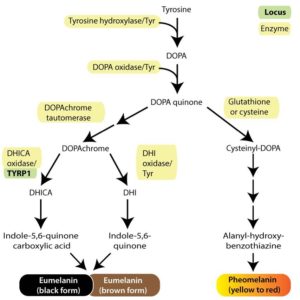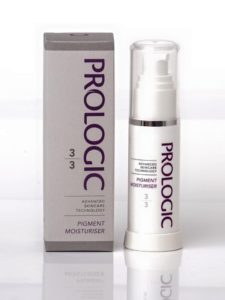![]() Most of the time the process is totally started by ultraviolet radiation or exposure to the sun. We unfortunately have an extremely high level of UVR in NZ, this is true even in winter and therefore I always encourage the Use of a broad-spectrum SPF 15 with Antioxidants!
Most of the time the process is totally started by ultraviolet radiation or exposure to the sun. We unfortunately have an extremely high level of UVR in NZ, this is true even in winter and therefore I always encourage the Use of a broad-spectrum SPF 15 with Antioxidants!
The UVR is stage one and is the main trigger for Stage two of Pigmentation.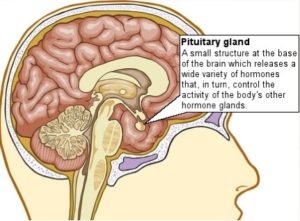
So, let’s have a look at stage 2. We have a precursor protein called Proopiomelanocortin or POMC for short, that produces the Melanin Stimulating Hormone (MSH), Corticotrophin and a b-Endorphin. This is only produced once the Pituitary Gland is exposed to UVR. Once we have started to produce the MSH by the Pituitary Gland it starts to regulate the synthesis of pigment granules, this lovely hormone is also responsible for regulation of the concentration and distribution of Melanin within the pigment containing cells or Melanocytes.
Stage 3, coul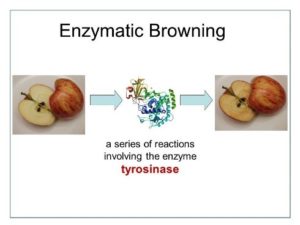 d it get any more complicated? Yes, it can! Let’s look at that happens now that we have stimulated the MSH. This next step involves an enzyme and an amino acid. Tyrosine and Tyrosinase. Tyrosine is an amino acid made by the body, responsible for the formation of the melanosome. Tyrosinase is an enzyme of human tissues responsible for the formation of the melanosome and the other pigments from tyrosine by an oxidation process.
d it get any more complicated? Yes, it can! Let’s look at that happens now that we have stimulated the MSH. This next step involves an enzyme and an amino acid. Tyrosine and Tyrosinase. Tyrosine is an amino acid made by the body, responsible for the formation of the melanosome. Tyrosinase is an enzyme of human tissues responsible for the formation of the melanosome and the other pigments from tyrosine by an oxidation process.
Stage 4 continues with the building blocks of melanin; this process happens with Dopa and L-Dopa Phosphates. The enzymatic oxidation of L-tyrosine L-Dopa by tyrosinase if a reaction where the L-Dopa is used as a cofactor is the initiator in this process. The Melanin has now been produced, this is what is responsible for giving our skin colour. This colour is then broken down into two categories. Pheomelanin which is red and Eumelanin which is brown.
![]() The la
The la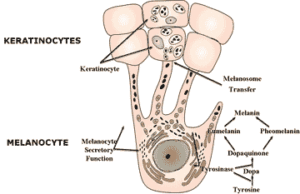 st stage is the transfer of the Melanosome, the melanin is darkened upon the transfer of the melanosome to the keratinocyte and the distribution to the surface of the epidermis starts! So now we know how this pigmentation starts, the process it goes through and the 5 stages it takes to reach the surface of the skin, what do we do now? We need to be looking for key ingredients in our products that inhibit the action of each process. We really need to stop pigmentation process at each stage to really and effectively treat pigmented disorders. So, let’s have a look at what we can use at each stage and what is important! Antioxidants to help prevent oxidative stress in the pigment formation process. Be sure to check other ingredients within your products, what are the actives? Do they help with barrier function? Do they help with repair? Are you feeding the skin cells what they need??
st stage is the transfer of the Melanosome, the melanin is darkened upon the transfer of the melanosome to the keratinocyte and the distribution to the surface of the epidermis starts! So now we know how this pigmentation starts, the process it goes through and the 5 stages it takes to reach the surface of the skin, what do we do now? We need to be looking for key ingredients in our products that inhibit the action of each process. We really need to stop pigmentation process at each stage to really and effectively treat pigmented disorders. So, let’s have a look at what we can use at each stage and what is important! Antioxidants to help prevent oxidative stress in the pigment formation process. Be sure to check other ingredients within your products, what are the actives? Do they help with barrier function? Do they help with repair? Are you feeding the skin cells what they need??
To Stop Stage 1-UVR we recommend Environ RAD Spf 15-RAD SPF 15 is a sun protection cream containing sun filters and reflectors to provide SPF 15 sun protection, along with antioxidants, titanium dioxide, beta-carotene and vitamins C and E which help to fight free radicals. It is suitable for all skin types and all ages, including babies older than six months
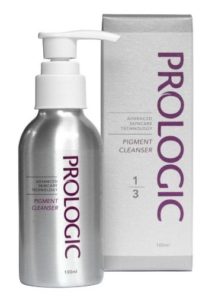
Prologic Pigment Cleanser- Step 1 on 3 specialised pigmentation products. Lactic acid, an effective Tyrosinase Inhibitor, treats the effected Melanocyte cells. While Lecithin and Linseed Oils support the skins natural barrier functions. This Product will help us stop Stage 3 of the pigmentation process.
Prologic Pigment Serum- Step 2 of 3 specialised pigmentation products. This product contains Sepiwhite or Undercylenoyl Phenylaline an effective MSH inhibitor, Niacinamide which is and effective Melanosome transfer Inhibitor. While the Hyaluronic acid increases water levels in the skin. This product stops stage 2 and 5 of the pigment process
Prologic Pigment Moisturiser- Step 3 of 3 specialised pigmentation products. Contains Aloesin an effective Dopa and L-Dopa Phosphate inhibitor. Also contains Magnesium Ascorbyl Phosphate a Tyrosinase inhibitor, Liquorice extract, Vitamins A, C, E and Squalene which all help strengthen barrier function. This Product works on stage 3 and 4 of the pigmentation process


